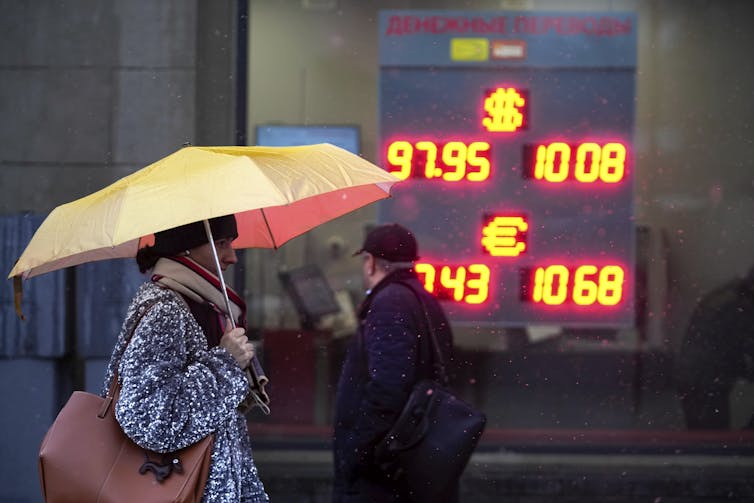In the months prior to the November 2024 presidential election in the United States, Donald Trump claimed that if elected to office, he would end the war in Ukraine “in one day.” By Christmas Eve, the president-elect had moderated his claim, suggesting only that he would bring Russia and Ukraine to the negotiating table.
On several counts, Trump’s chances seem slim if the object is to find a solution acceptable to both sides.
Russia’s war is costly in terms of human losses for territory gained. A recent report stated that the Russian army was losing 1,500 troops per day in the eastern region of Donbas as it attempts to break through Ukrainian resistance. The death toll has led to fears of a demographic crisis for ethnic Russians. According to one analyst, it could result in a population that is “smaller …more fragile and less well educated.”
The Russian elite is also reportedly frustrated with President Vladimir Putin’s war strategies and his failure to bring about a timely victory.
Western sanctions have slowly begun to bite. Export revenues have declined and the Russian ruble dropped significantly in comparison to the U.S. dollar in December 2024. Ukraine cut off Russia’s gas pipeline to Europe on Jan. 1 “in the interests of national security.”

(AP Photo/Pavel Bednyakov)
Russia’s ultimate objective
It would therefore seem logical for Russia to welcome Trump’s initiative. But as chess grand master and activist Garry Kasparov explains, Russia’s ultimate goal is to destroy the Ukrainian state. He also argues that Russian opposition leaders mirror the imperialist aims of the leadership.
Russia treats occupied Ukrainian territory as a colony. An international human rights lawyer says it deports children to Russia and Belarus to be “re-educated.” Human Rights Watch says Russia
forces Ukrainian men into the Russian army, while the United Nations has said it brutalizes the local population and tortures.
Ukrainian officials have also accused Russia of executing prisoners of war.
Under these circumstances, Ukraine is understandably reluctant to come to the table. It has achieved some successes in the war. In the first 27 months, Russia suffered the loss of a third of its Black Sea Fleet and abandoned its blockade of Ukrainian ports. Russia resorted to using submarines to maintain a naval presence in the region.
Last August, part of the Ukrainian army crossed the border into the Kursk region, occupying about 100 square kilometres of territory. The sudden incursion caught the Russians by surprise and brought a positive note into an otherwise gloomy year for Ukraine. It also revealed a lack of resistance and war disillusionment among the occupied Russian population.

(Vyacheslav Prokofyev, Sputnik, Kremlin Pool Photo via AP)
Ukrainian recruitment tactics
But the loss of troops was detrimental to Ukraine’s operations in the Donbas region and allowed Russia to occupy several towns on the approach to Kramatorsk and Sloviansk. Furthermore, the arrival of troops from North Korea in support of Russia widened the conflict.
Read more:
Amid the West’s wavering aid to Ukraine, North Korea backs Russia in a mutually beneficial move
In April 2024, Ukrainian President Volodymyr Zelenskyy signed a new law obligating males aged 25-60 to provide information about their draft status. It offered bonuses to volunteers and enhanced punishment for those evading the draft.
However, dodging the draft has become widespread. Patrols search towns for potential recruits, looking in subways and nightclubs, and sometimes using brute force to coerce the reluctant.
Support for the war in Ukraine is declining. A Gallup poll conducted last fall revealed that more than half of respondents supported negotiations to end the war. The high losses, grave injuries to citizens and lack of progress have resulted in fear and war weariness.
One recent analysis argues that unless the U.S. government delivers on military aid to Ukraine, the likely outcome is a catastrophic Ukrainian defeat within 12-18 months, bringing a loss of sovereignty and Russian rule to Ukraine.

(AP Photo/Dan Bashakov)
Ukraine wants security guarantees
Zelenskyy justifiably seeks some guarantees for Ukraine in any negotiations. Official casualties are just under half a million — less than for Russia — but because Ukraine is less populous than Russia, the losses are more costly.
Gradually, western offers of security have receded. NATO membership for Ukraine is evidently off the table thanks to the reluctance of the U.S. and Germany. And while outgoing U.S. president Joe Biden announced his final aid package on Jan. 9 worth US$500 million, he remained reluctant to allow the export of long-range weapons that could threaten Russian territory.
Read more:
Delays in western aid have put Ukraine in a perilous position
Zelenskyy therefore has choices to make. By extending the age of conscription to the age group 18-24, as Biden has suggested, he could double the size of the Ukrainian army and fight on. But the move would be highly unpopular.
He could place his hopes on negotiations with the unpredictable Trump. But that would likely incur the permanent loss of Crimea, the Donbas region and Russian-occupied parts of Kherson and Zaporizhzhia without providing future security.

(AP Photo/Susan Walsh)
The fate of western sanctions
For Ukraine, therefore, there is little incentive to negotiate. Past security guarantees such as the Budapest Memorandum of 1994 have been broken summarily by Russia. And the West has proven a frustrating partner, one that offers support without commitment.
For Russia, the return of Trump has provided an opportunity to negotiate a deal that could end western sanctions and provide solace for its appalling war losses.
But it is unlikely to satiate Russia’s leaders unless it satisfies the revised goals of Putin’s so-called “special military operation” in Ukraine — to occupy the four regions of Ukraine, end its NATO ambitions and ultimately eliminate Ukrainian statehood.
